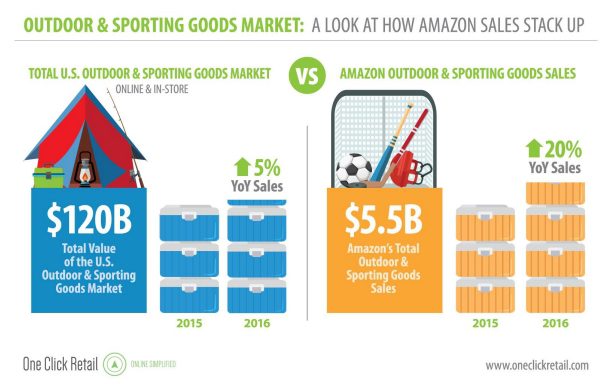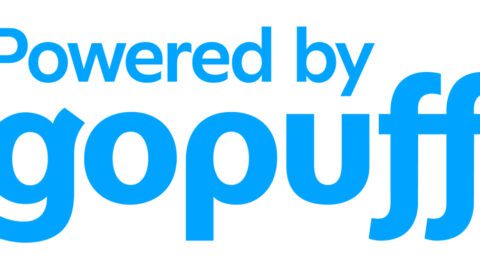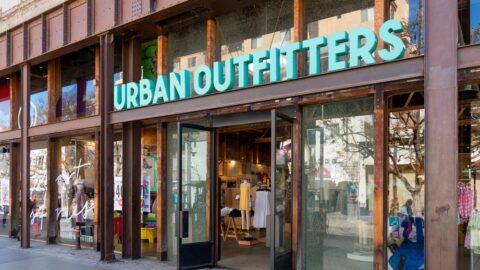Amazon accounted for less than 5% of all U.S. outdoor and sporting goods sales in 2016 — $5.5 billion out of a total market of $120 billion. But with a growth rate that is four times the 5% achieved by the industry as a whole, Amazon is likely to rack up bigger numbers on the scoreboard before long.
These stats have brought Nathan Rigby, VP of Sales and Marketing at One Click Retail, to one conclusion: brands must build a working relationship with the e-Commerce giant. In fact, he believes that modern outdoor and sporting goods brands that don’t have a data-driven Amazon strategy in place will underperform or go bankrupt within the next five years.
“This is a classic moment where any time a brand believes it can shape consumer demand rather than following where consumers were going, they will ultimately lose,” Rigby said in an interview with Retail TouchPoints. “Many really well-known brands are resistant to engaging with Amazon and they do it to their own peril. The fact is, the consumer will dictate where they want to go and the brands can either play or not play, and their decisions will shake their future growth and opportunities.”
Advertisement
The “Amazon Effect” has already inflicted drastic changes for many long-established outdoor and sporting goods brands, with retailers such as Sports Authority and Sport Chalet going out of business, Golfsmith and Eastern Outfitters getting bought out by bigger players and Bass Pro Shops merging with Cabela’s.
Yes, consumers often like to try out sports products before they buy them. And experiential retailing should be a major part of any in-store strategy to generate foot traffic. But Amazon’s rapid growth rate indicates that these factors still aren’t slowing the e-Commerce giant down when it comes to product sales.
The top growth categories within sporting goods, outdoor equipment and most prominently, athletic apparel, all indicate that Amazon is reeling in revenue from multiple sources, including items that would traditionally have been purchased in brick-and-mortar stores. Some top-growing products include:
-
Athletic underwear: 145%;
-
Baseball apparel: 100%;
-
Coolers: 100%;
-
Swimwear: 90%;
-
Electronic scooters: 90%;
-
Fitness apparel: 85%;
-
Athletic bags: 75%;
-
Hats/caps: 70%;
-
Hunting apparel: 65%; and
-
Bikes: 50%.
Yet even with these remarkable growth rates, the sentiment is that Amazon is still underperforming in a number of areas — meaning that it’s only a matter of time before these sales numbers increase even more.
“There are inherent problems that are better fulfilled by Amazon,” Rigby said. “If I only have a small sedan, bringing my kid’s bike home is a hurdle because I don’t have the space to transport it from DICK’S Sporting Goods to my home. Amazon provides that solution that I didn’t have. There’s no area on Amazon yet that’s even past the infancy stage that’s even close to saturation.”
As Amazon Dominates Search, SEO Become Priority
One of Amazon’s biggest advantages is a simple product search option. Other retailers and brands must understand and optimize online search on their own sites if they have any chance of standing out as an e-Commerce presence, said Rigby.
“90% of all purchases on Amazon begin with search,” Rigby noted. “If people don’t find what they’re searching for with the first iteration, they’re actually just going to retype their search and look for a more refined search parameter. 80% of those searches remain on the first page, while 62% remain on the top three items. In the old days, it was all about owning shelf space. Now, it’s all about being able to surface to the highest levels of search parameters, because rarely do any of us actually search beyond the first page. Getting search right influences both your success on Amazon as well as your success in the omnichannel retail space.”
Brand Loyalty Fuels Direct-To-Consumer Sales
While Amazon’s prowess is a large factor contributing to the decline of many of these retailers, consumers’ growing preference for buying directly from their favorite brands or team also cuts into traditional sales channels. One measure of this change is the growth of first-party sales of licensed products on Amazon.
All the major sports experienced major growth within licensed product sales on Amazon in 2016, including:
-
Soccer (MLS): 200%;
-
Pro basketball (NBA): 150%;
-
Football (NFL): 60%;
-
Hockey (NHL): 60%;
-
College basketball (NCAA): 40%; and
-
Baseball (MLB): 15%.









